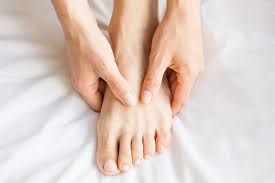Foot pain can be a real hassle, especially when it interferes with your daily activities like walking or standing. Whether it's a sharp pain in the bottom of your foot or a dull ache in your toes, understanding the causes and finding effective treatments is crucial for relief.
In this article, we'll delve into the various reasons behind foot pain and explore ways to alleviate it, ensuring you can get back to your day-to-day life pain-free.
Foot pain can arise from a variety of factors, ranging from lifestyle choices to medical conditions. Here are some of the most common causes:
Poor Footwear
Ill-fitting shoes are a leading cause of foot pain. Shoes that are too tight, too loose, or lack adequate support can lead to discomfort and even injury. High heels and shoes with narrow toe boxes can cause pain in the toes, while flat shoes without arch support may lead to pain in the bottom of the foot.
Overuse and Activity
If you suddenly increase your activity level, your feet might not be ready for the extra strain. This overuse can cause pain in various parts of the foot. Runners and athletes often experience this, but it can happen to anyone who's on their feet a lot.
Medical Conditions
-
Plantar Fasciitis: This condition causes pain in the heel and the bottom of the foot. It's due to inflammation of the plantar fascia, a thick band of tissue that runs across the bottom of your foot.
-
Arthritis: Arthritis can cause joint pain and swelling, which may affect the feet.
-
Bunions: These are bony bumps that form at the joint of your big toe, leading to pain and discomfort.
-
Neuropathy: Often associated with diabetes, neuropathy can cause pain, tingling, or numbness in the feet.
Injury
Injuries such as sprains, fractures, or strains can lead to immediate and severe foot pain. Even minor injuries can cause significant discomfort if not treated properly.
Foot Structure
Some people have naturally flat feet or high arches, which can contribute to pain. These structural differences can cause uneven weight distribution, leading to discomfort.
Symptoms of Foot Pain
Recognising the symptoms of foot pain is the first step in finding relief. Symptoms can vary depending on the cause, but may include:
-
Sharp or stabbing pain
-
Dull, aching discomfort
-
Swelling or redness
-
Numbness or tingling
-
Difficulty walking or standing
If you experience severe pain, swelling, or an inability to bear weight on your foot, it's important to seek medical attention.
How to Treat Foot Pain
There are several ways to alleviate foot pain, ranging from home remedies to medical treatments. Here's how you can find relief:
Home Remedies
-
Rest and Ice: Resting your foot and applying ice can reduce inflammation and alleviate pain.
-
Proper Footwear: Choose shoes that fit well and provide adequate support. Consider using orthotic inserts for added comfort.
-
Stretching Exercises: Gentle stretching can help relieve tension in the muscles and ligaments of the foot.
-
Foot Massage: Massaging the affected area can increase blood flow and reduce pain.
Medical Treatments
If home remedies aren't enough, you may need to explore medical treatments:
-
Physical Therapy: A physical therapist can teach you exercises to strengthen your feet and improve flexibility.
-
Medications: Over-the-counter pain relievers or anti-inflammatory medications can help manage pain.
-
Injections: Corticosteroid injections may reduce inflammation and relieve pain in certain conditions like plantar fasciitis.
-
Surgery: In severe cases, surgical intervention may be necessary to correct structural issues or remove painful bunions.
Preventing Foot Pain
Preventing foot pain is often easier than treating it. Here are some tips to keep your feet healthy and pain-free:
-
Choose the Right Shoes: Always opt for shoes that offer proper support and fit well. Avoid wearing high heels or shoes with narrow toe boxes for extended periods.
-
Maintain a Healthy Weight: Extra weight can put added stress on your feet, leading to pain.
-
Warm-Up Before Exercise: Always warm up and stretch before engaging in physical activities to prevent overuse injuries.
-
Listen to Your Body: If you experience pain or discomfort, take a break and rest your feet.
When to See a Doctor
While minor foot pain can often be managed at home, certain symptoms warrant a visit to a healthcare professional. Seek medical attention if you experience:
-
Severe or persistent pain
-
Swelling that doesn't improve
-
Signs of infection, such as redness or warmth
-
Numbness or tingling
In conclusion, understanding the causes of foot pain and implementing effective treatments can significantly improve your quality of life. By taking preventative measures and seeking appropriate care, you can keep your feet healthy and pain-free.
Remember, your feet carry you through life—take good care of them!








